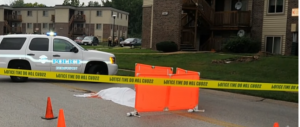6.8. Current Issues: Police Shootings
Tiffany Morey
One of the most controversial issues regarding policing in the 21st century is police shootings. This topic causes much debate and is always in the headlines of every media outlet when it occurs. After an officer-involved shooting, citizens want answers, and rightfully so. Unfortunately, police departments cannot immediately provide those answers. The all too familiar ‘no comment’ or ‘we do not have any information at this time’ or only providing limited facts, does not appease saddened or angry family members or the general public.
Police departments cannot comment because they may genuinely not know the entire story. Police unions are there to protect officers, and the officers need time between the shooting and when they are required to write the police report on the incident and answer questions about the shooting for a variety of reasons. Therefore, directly after the shooting, when the media or the general public wants answers, there might not be any answers known to give. However, this immediately reads as if the department has something to hide. Whether that is true does not matter in the eyes of many. An investigation must occur before the department can make a formal statement, and release body camera or dash-mounted camera footage and information about the shooting. All too often though, this information comes too late.
One case that signifies this all too well is the officer-involved shooting and killing of Michael Brown, in Ferguson, Missouri. [1]
In the News: Michael Brown- Ferguson Missouri – Officer Involved Shooting
https://www.youtube.com/watch?v=t2104nz_h5A

The riots that occurred during the aftermath of the incident resulted in numerous arrests, millions of dollars in property damage sustained, and almost insurmountable damage to the relationship between police and young Black males. The Ferguson Police Department, where the officer who shot and killed Michael Brown, had many issues; however, much of the information that the media released shortly after the shooting was later investigated and found incorrect.
Police officer-involved shootings are very serious. Officers train and qualify quarterly with their duty firearms and regularly review what is required to use deadly force. After every police-involved shooting (use of deadly force), once the investigation is complete, a grand jury or coroner’s inquest (depending on the jurisdiction and outcome of the shooting) must take place. There is a trial where the actions of the officer involved are examined to determine if the use of deadly force was justified. The officer describes in detail the shooting and why the officer felt it necessary to use deadly force. Witnesses take the stand and tell what they heard or saw. Finally, a jury decides whether or not the use of deadly force was justified. If the shooting is justified, the officer will not face formal charges for the use of the use of deadly force. However, if the shooting is determined to be unjustified, the officer can face felony charges, up to the murder. Generally, at this point, the officer is fired from the respective police department, and the prosecutor’s office files charges against the officer. For instance, at the Portland Police Bureau, any use of deadly force goes through eight different reviews, to determine if the officer was justified.
- Department of Justice. (2015). Department of Justice report regarding the criminal investigation into the shooting death of Michael Brown by Ferguson, Missouri police Officer Darren Wilson. Washington, DC: Department of Justice. ↵

